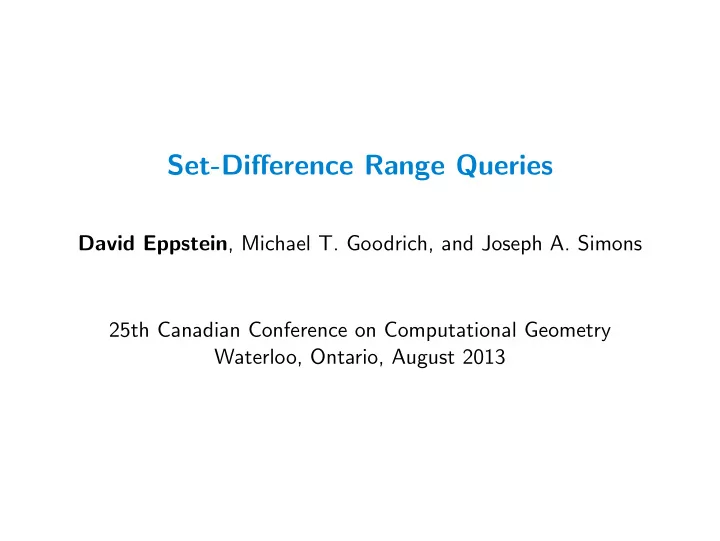

Set-Difference Range Queries David Eppstein , Michael T. Goodrich, and Joseph A. Simons 25th Canadian Conference on Computational Geometry Waterloo, Ontario, August 2013
Spot the difference A popular type of children’s puzzle CC-BY-SA image File:Spot the difference.png by ja:user:Muband on Wikimedia commons
The discovery of Pluto The original plates from Clyde Tombaugh’s discovery of Pluto, recolored to make the arrow markers more obvious
Detecting alterations of photographic images Kliment Voroshilov, Vyacheslav Molotov, Joseph Stalin, and Nikolai Yezhov, 1937 After Before
Local differencing Find differences within a restricted subset of the input (e.g. to avoid getting distracted by bigger differences elsewhere)
Non-imaging applications of local differencing ◮ Synchronize calendars for a range of dates ◮ Reconcile a range of database transactions ◮ Find variant DNA in one or more genes of a genome ◮ Track a small set of moving objects among many non-moving objects ◮ Communicate updated data for a windowed view Google Maps live traffic display near Orange County of a road map Airport, California, 2013-08-01 16:30
Our contributions Main contribution: Formulate set difference range querying , a formalization of the local differencing problem within the framework of range query data structures Secondary contribution: Combine known data structural techniques for decomposition of range queries and for streaming straggler detection to solve set difference range queries efficiently
Range spaces A range space consists of ◮ A family of objects parameterized by O (1) real numbers ◮ A family of ranges parameterized by O (1) real numbers ◮ An incidence relation between objects and ranges e.g. points in the plane, rectangles, containment
Range querying Input: finite set of objects from a range space, a value for each object, and an (associative, commutative) aggregation operator Preprocessing: construct a space-efficient data structure Query: find points in a query range and return their aggregate value To count points in range: value = 1, aggregate = addition To find top priority point: value = priority, aggregate = max To list all points in range: value = self, aggregate = union
Set difference range queries Data: One or more sets of objects Object values = members of some universe of sets Query: two ranges (possibly in different sets of objects) Aggregation: Elements that belong to one range but not both (symmetric difference of sets)
Canonical ranges Standard strategy for range query problems: ◮ Identify a small set of canonical ranges ◮ Store the aggregate value of each canonical range ◮ Decompose query ranges Example: kD -tree into few canonical ranges O ( n ) canonical rectangles Query rectangle decomposes into O ( √ n ) canonical rects
Group vs semigroup models + - Semigroup: query decomposed Group: query decomposed into into disjoint canonical ranges overlapping canonical ranges Can be combined using only Inclusion-exclusion formula the aggregate operator using subtraction Allows more general types of Allows more general types of aggregation decomposition
Set differencing in the group model Instead of sets, use multisets : integer counts of how many times each element appears The members of a multiset are the elements with nonzero counts Vectors of counts can be added and subtracted The set difference is just the subtraction of two vectors PD image File:Tally marks counting visitors.jpg by Achird on Wikimedia commons
Invertible Bloom filters [E & Goodrich, WADS 2007 & IEEE TKDE 2011] { x, y, z } Hash each element to O (1) cells of a table, #cells = O(capacity) Each cell stores � elements, #elements, checksum Can add/subtract multisets of arbitrary size (by adding/subtracting values in each cell) Decode by finding cells containing only one element, possible whenever size of result ≤ capacity
How to perform set-difference range queries ◮ Construct a family of canonical sets ◮ Decorate each set with invertible Bloom filters of capacities 1 , 2 , 4 , . . . set size ◮ To handle a query: ◮ Decompose into canonical ranges ◮ For capacity = 1 , 2 , 4 , . . . , add/subtract canonical IBFs to construct an IBF for U.S. Navy photo the difference of the two query ranges 050215-N-2636M-015, ◮ When capacity is large enough for the Nick Leones, by Kleynia resulting IBF to be successfully decoded, stop and return the result McKnight
Analysis Space = input size × number of canonical sets per object, similar to other typical range query data structures (Slightly more space-efficient if output size fixed in advance) Query time = output size × number of canonical sets per query Can also be modified to return approximate cardinality of result, with query time polylog × number of canonical sets (Uses frequency moment estimation sketch in place of IBFs)
Conclusions New, natural and useful range querying problem Efficient solutions, independent of the exact shape of the ranges, that can be combined with most other range querying techniques The blink comparator used by Clyde Tombaugh to discover Pluto CC-BY-SA image File:Lowell blink comparator.jpg by Pretzelpaws on Wikimedia commons
Recommend
More recommend